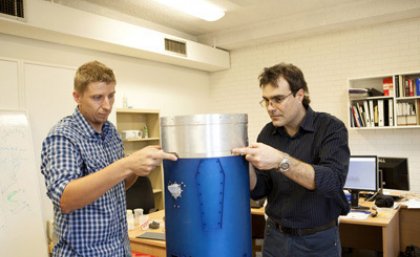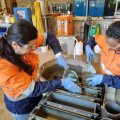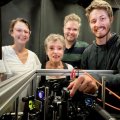
An exotic ceramic material that could one day be used to build hypersonic flight craft will be hitching a ride on a free-flying scramjet flight experiment built by The University of Queensland’s SCRAMSPACE flight team.
Scientists from the Italian Aerospace Research Center (CIRA) were in Brisbane recently to install two winglets made from Ultra High Temperature Ceramic (UHTC) onto the outer skin of the scramjet, in preparation for a test flight in Norway later this year.
The flight, SCRAMSPACE I, is one of the activities of the international 13-partner $14M SCRAMSPACE Scramjet-based Access-to-Space Systems project, part funded by the Australian Space Research Program.
Scramjets are air-breathing engines capable of travelling at hypersonic speeds.
SCRAMSPACE I will be boosted to these speeds by a two-stage rocket that launches the scramjet out of the atmosphere and into space. The rocket will be launched by the Mobile Rocket Base (MORABA) of the German Aerospace Center (DLR), one of the SCRAMSPACE partners.
After leaving the atmosphere, the 1.8m scramjet vehicle will separate from the rocket and orient itself for the re-entry with small thrusters. During the descent, the vehicle will be accelerated by gravity to Mach 8 – about 8600 kilometres per hour. The actual experiment takes place when the scramjet has dropped to altitudes where there is enough air to enable the engine to operate.
Dr Sandy Tirtey, Project Manager and Technical Lead for the flight experiment, said the scramjet would reach tremendous speeds that create extreme heat, so it was the ideal opportunity to test the material in a true flight environment.
“When the jet turns to come back to earth, it reaches speeds of Mach 8 (8600km/h) in the atmosphere. When reaching the denser part of the atmosphere on its way down, it starts to heat up very quickly, up to 1500 degrees Celsius, ” Dr Tirtey said.
Lab tests have already proven that the UHTC can withstand a temperature of 2000 degrees Celsius, and functional testing is a vital next step in establishing its suitability for practical application.
According to SCRAMSPACE Director and Scientific Lead for the flight, Professor Russell Boyce, it will take advantage of the rare opportunity to test not only Australia’s world-leading scramjet science in hypersonic flight conditions, but also high temperature materials and construction methods, advanced avionics, instrumentation and telecommunications.
For example, The University of New South Wales (UNSW) will use the flight to test a diode-laser-based flight-conditions monitor, and a high temperature carbon-fibre thrust nozzle from Teakle Composites in Brisbane will be important to ensure the outcomes of the flight.
A collection of in-flight temperature and pressure sensors will enable the rapid collection of all necessary data before the scramjet disintegrates as it reaches dense air at low altitude.
“The scramjet is not designed to survive, but the spirit of the project is to get the data that will demonstrate that all the tools we have been working on for the last few years are working,” Dr Tirtey said.
CIRA Thermo-Structural expert Dr Roberto Gardi said the UHTC ceramic would not melt, but it could break, so researchers need to find ways to attach the brittle ceramic to more conventional materials.
“We want to have the structural behaviour of metal and the thermal protection of ceramic – the best of two worlds,” he said.
The CIRA team, together with UQ’s flight team, worked together to attach the ceramic in the form of two small “winglets”, about the size of a door handle, onto the outer shell of the scramjet. After screwing it into place, they then had to painstakingly remove any protrusion.
“It is important to have a smooth surface, since a local imperfection can cause much heating. A protrusion of even 0.1mm can cause heating of up to 10 times – and burn the surface,” said Dr Gardi.
“Everything we do takes a lot of time. We need to be sure nothing is going to come loose because of vibrations. We only get one shot.”
The ultimate aim is to find materials that can be used to build parts for practical applications such as hypersonic aircraft for passenger flight and for transporting satellites to orbit efficiently and quickly.
Theoretically, hypersonic passenger aircraft could fly up to Mach 6, 7 and beyond, Dr Tirtey said.
“The hypersonic planes of the future will have a sharp shape such as the Concorde (which reached speeds of Mach 2), but the nose will be the hottest part, as well as the edge of the wings. So we need a different material to make these parts,” Dr Tirtey said.
Quality Assurance and Project Manager for CIRA’s winglets, Dr Antonio Del Vecchio, said the test flight was a golden opportunity.
“It is not easy to have access to space flight, so experimenting is not easy,” he said.
It would be CIRA’s second flight test on ceramic space flight materials since the research started in the 1960s. The first was in 2010 in Sweden.
About the SCRAMSPACE project
SCRAMSPACE was the first and largest project funded by the Australian Space Research Program. Building on Australia’s world-class hypersonics heritage, its core objective is to build capacity and capability, in particular a talent pool, for the Australian space and aerospace industry.
This is achieved partly by means of the Mach 8 flight experiment, for which a team of exceptional young scientists and engineers has been assembled, and partly through extensive ground-based research involving many PhD students at UQ and partner universities.
Partners in the program include four Australian universities — UQ, UNSW, the University of Adelaide and the University of Southern Queensland — and a US university, the University of Minnesota.
It also includes Australia’s Defence Science and Technology Organisation, who have assisted with training and access to equipment; industry partners BAE Systems, Teakle Composites and AIMTEK; aerospace agencies and research organisations from Germany (DLR), Japan (JAXA) and Italy (CIRA); and the Australian Youth Aerospace Association.
CIRA
CIRA was created in 1984 to manage PRORA, the Italian Aerospace Research Program, and uphold Italy’s leadership in Aeronautics and Space.
CIRA is a company with public and private sector shareholders. The participation of research bodies, local government and aeronautics and space industries sharing a common goal has led to the creation of unique test facilities, unmatched anywhere in the world, and of air and space flying labs.
The CIRA is located in a 180-hectare area north of Naples. It has a staff of 320, most of whom are engaged in domestic and international research.
Media: Janelle Kirkland, UQ Communications, 07 3346 0561 or j.kirkland@uq.edu.au
.jpg)








